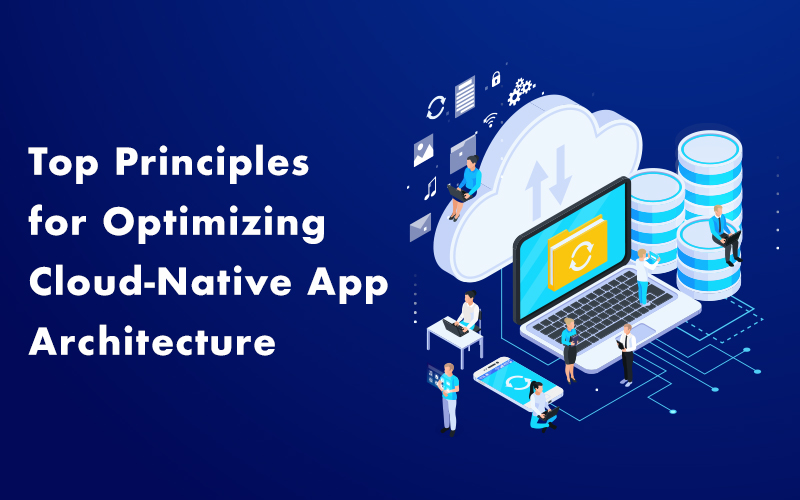The principle of architecting for cloud-native architecture focuses on how to optimize system architectures for the unique capabilities of the Cloud. Traditional architecture tends to optimize for a fixed, high-cost infrastructure, which requires considerable manual effort to modify. Traditional architecture, therefore, focuses on the resilience and performance of a relatively small fixed number of components.
However, Cloud has a fixed infrastructure as it charges based on usage, and it’s also much easier to automatically scale-up and down. Therefore, cloud-native architecture focuses on achieving resilience and scale through horizontal scaling, distributed processing, and automating the replacement of failed components.
Significant Characteristics for Dynamic Adaptation of Cloud-native Architecture
Cloud computing provides an abstract infrastructure and delivers on-demand services. For the maximum advantage of Infrastructure-as-a-Service (IaaS) capabilities, cloud applications are a collection of loosely coupled services to mimic and adapt to the current computing paradigms. Here are the key attributes for optimizing such an app architecture:
Highly Distributed
Cloud-native app architecture services can dynamically support massive numbers of users, large development organizations & highly distributed operations teams. This requirement is even more critical when one considers that cloud computing is inherently multi-tenant in nature. Within this area, a typical concern it accommodates is the ability to scale up and down the deployment footprint dynamically. It can gracefully handle failures across tiers that can disrupt application availability by accommodating large development teams. It also ensures that the components provide loose coupling by implementing any kind of virtual infrastructures like computing, storing, and network.
Deep Defense Approach
The approach from traditional architectures has always been vulnerable to insider attacks, as well as external threats such as spear phishing. Moreover, the increasing pressure to provide flexible and mobile working has further undermined the network perimeter. Cloud-native architectures have their origins in internet-facing services, and so have always needed to deal with external attacks. They adopt an approach of defence-in-depth by applying authentication between each component. By minimizing the trust between those components, there is no ‘inside’ and ‘outside’. This makes the architecture very resilient, which results in an easier cloud deployment, even if there isn’t any trusted network between the service and its users.
Managed Services
Managed services can often save the organization hugely in time and operational overhead. These include managed open source or open source-compatible services like Cloud SQL, which have little risk. Others include managed services with high operational savings that aren’t immediately compatible with open source but are easier to consume. Then there are the complex cases where there is no easy migration path off of the service, and it presents a less apparent operational benefit. However, the potential risk of having to migrate off of them rarely outweighs the considerable savings in time, effort, and operational risks in the long run.
Independent Systems
Cloud-native are server/operating system independent where you need different capabilities ranging from Machine Learning models with TPU/GPU prediction result from exposing API on specific machines. Services that are persistent and durable follow a different pattern that assures higher availability and resiliency. Cloud-native applications don’t have an affinity for any particular operating system or individual machine and operate at a higher abstraction level. The only exception is when a microservice needs specific capabilities, including solid-state drives (SSDs) and graphics processing units (GPUs), that may be exclusively offered by a subset of machines. The connection between storage and container usage depends on the persistence levels in context with the state, statelessness, and even micro-storage environments.
Loosely Coupled
Services that belong to the same application discover each other through the application runtime and exist independent of other services. Elastic infrastructure and application architectures, when integrated correctly, can be scaled-out with efficiency and high performance. Loosely coupled services allow developers to treat each service independent of the other. With this decoupling, a developer can focus on the core functionality of each service to deliver fine-grained functionality. Developing loosely coupled services is the best fit for Agile methodology as well. Every agile team can work independently, and each team will only focus on the assigned function. This approach leads to efficient lifecycle management of the overall application because each service is maintained separately and with clear ownership.
API Interactions and Protocols
APIs provide developers and administrators with the ability to assemble digital applications such as microservices. APIs work as an interface for loosely coupled microservices to abstract out the internals of the underlying application components. Developers also use well-defined APIs to interact with the overall cloud infrastructure services that enable provisioning, deploying, and managing platform services. Cloud-native services use lightweight APIs, based on protocols such as representational state transfer (REST), Google’s open-source remote procedure call (gRPC) or NATS. REST exposes APIs over hypertext transfer protocol (HTTP), while gRPC facilitates performance with internal communication among services. NATS has publish-subscribe features which enable asynchronous communication within the application.
Multiple Data Storages
Cloud-native applications can be highly automated, working on the concept of infrastructure as code. These applications deploy on virtual, shared and elastic infrastructure that aligns the underlying infrastructure with adjusting themselves based on the varying load dynamically. CN applications can work with data formats of the loosely structured kind as well as the regularly structured data. This implies the need to support data streams that are not just high speed but also are better suited to NoSQL/Hadoop storage. These systems provide Schema on reading (SOR), which is an innovative data handling technique with individual microservices having their local data storage.
Concluding Thoughts
One of the core characteristics of a cloud-native system is that it’s always evolving, and that’s equally true of the architecture. A cloud-native architect should always seek to simplify and improve the architecture of the system according to the changing needs, the landscape of IT systems, and capabilities of the organization. WeCode is a leading cloud-native app development company that continues to grow and respond to evolving IT systems. Our developers rapidly work towards bringing the required security, immunity, and opportunities for your organization.


